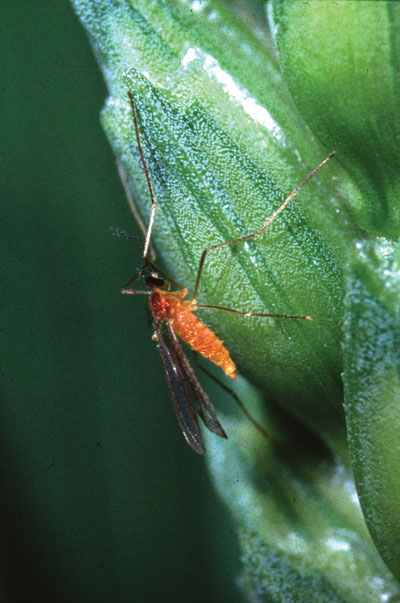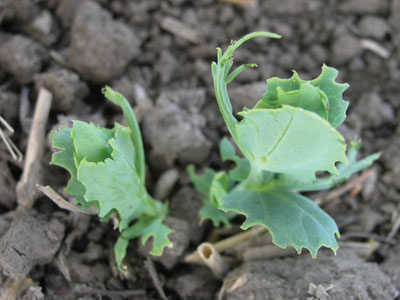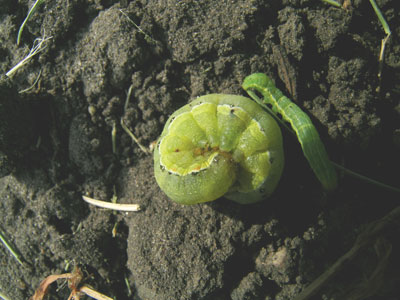
Features
Agronomy
Insect Pests
The good, the bad and the ugly of insect pests
As usual, the insect problems in 2008 reflected the good, the bad and the ugly, as some insect populations cycled up and others were down. Here is what to expect for 2009.
May 4, 2009 By Bruce Barker
As usual, the insect problems in 2008 reflected the good, the bad and the ugly, as some insect populations cycled up and others were down. Here is what to expect for 2009.
 |
|
| Wheat midge requires monitoring to ensure good control. Photo courtesy of AAFC-Saskatoon Research Centre |
Cutworms were moderate to bad in some areas of Manitoba, and were a concern on many crops in 2008. Dr. John Gavloski, an entomologist with Manitoba Agriculture, Food and Rural Initiatives says that cutworms may be reaching the peak of their population cycle in many areas, and may start to cycle downwards. In Saskatchewan cutworms also have been problematic. In 2008, above ground, foliar feeding cutworms caused significant damage in western regions.
Grasshopper forecasts are now posted on provincial government websites. For 2009, hot spots may develop, including southwest Manitoba, southeast Saskatchewan, several areas through central Saskatchewan north of Regina and Moose Jaw, and down through Swift Current.
Oilseed insects
Cabbage seedpod weevil is firmly established in southern Alberta, and has become a perennial insect of concern. While the geographic infestation boundary spread north of Highway #1, the main area of concern was south of the Trans-Canada highway in Alberta, where spraying is now a routine operation. As usual, early seeded canola is hit the hardest. In 2008, there were concerns that canola fields were sprayed too early, before the canola was even bolting, which can result in poor control as weevils move into canola as it comes into bloom. Spraying too early may also impact beneficial insects. Environmental conditions in 2008 appear ideal for weevil larval development in 2009.
“The larvae seems to do better when moisture in August is favourable, so we expect 2009 to be a potentially severe problem,” says Scott Meers, insect management specialist with Alberta Agriculture and Rural Development.
In Saskatchewan the cabbage seedpod weevil’s range has expanded north of the South Saskatchewan River and east near Regina as shown in the 2008 Cabbage Seedpod Weevil Survey conducted by Agriculture and Agri-Food Canada and the Saskatchewan Ministry of Agriculture.
Good news on the bertha armyworm front. They were almost non-existent in 2008 in Alberta and Manitoba, and have been on a downslide since 2006. Chemical control for this pest was also greatly reduced in Saskatchewan as compared to 2007. Bertha armyworm prediction maps, based on male moths collected in pheromone traps will be developed again in-season (June and July) and available on government websites to help producers with scouting activities.
Diamondback moth was not present in Alberta or Manitoba in economically significant numbers. Diamondback moth infestations occurred in several areas in Saskatchewan with some of the highest infestations south of Regina and Moose Jaw, near Avonlea. The insect does not over-winter well in Western Canada, and moves up from the US on winds. Monitoring will continue in 2009.
Flea beetles were of little concern in 2008 across the Prairies. Where damage did occur, it was because canola was growing slowly due to the cold spring. Fall numbers in southern Alberta, though, may indicate an increase in 2009. “If you saw large numbers of flea beetles on mature canola, that is an indication that populations could be higher in 2009, and you might want to consider bumping up seed treatments,” says Meers.
Lygus bugs were found in canola in high numbers in the early flowering stage in much of the western part of south and central Alberta. Meers says that fields that were sprayed for cabbage seedpod weevil usually did not need to be sprayed for lygus bug. In Manitoba, populations were present at economic levels in the eastern part of the province.
Root maggot populations increased where soil moisture conditions were adequate to support larval development, with the biggest damage occurring in the Black soil zone in the Edmonton to Vermillion and Edmonton to Red Deer regions. Infestations of root maggots were observed in many canola fields in Saskatchewan particularly in central, west central and northwest regions. There was also some area of concern in the Manitou region of Manitoba. Since there are not any chemical control options, producers who increase seeding rates may have lower feeding damage. Tighter rotations favour the development of root maggots.
Potato aphids on flax caused localized damage in south-central Manitoba. Gavloski says there was some localized spraying. For 2009, he recommends that scouting continue in the areas where the insect was present in 2008.
Soybean aphids returned in 2008, following few problems in 2007. Many fields had economic levels in 2008, similar to 2006. Gavloski says the infestations are hard to predict since the insect is not known to over-winter in Manitoba, and infestations are thought to blow in on the wind.
 |
|
| Tell-tale scalloped notches indicate adult pea leaf weevil feeding. Photo courtesy of Carcamo. AAFC Lethbridge |
Cereal insects
Wireworms were once again a concern in 2008, with populations causing localized damage. For producers with wireworm damage in 2008, continued use of seed treatments is recommended in 2009.
Wheat stem sawfly infestations and damage trended lower in 2008. In Saskatchewan wheat stem sawfly continues to be a problem for producers in most areas where wheat is grown although reports of infestations have declined in the past year. For 2009, producers that have battled sawfly during the last few years should consider solid-stemmed wheat varieties as a control method.
Wheat midge was forecast to be a significant problem in Alberta in 2008, although populations were not as high as anticipated. Some spraying did occur. In Saskatchewan, the 2008 Wheat Midge Forecast map also indicated high populations in central and eastern Saskatchewan. High emergence of adult flies was reported in July. But in many instances the wheat crop was not in a susceptible stage at the time the female midge emerged.
In Manitoba, the highest levels of wheat midge were found in western Manitoba. Gavloski says Manitoba does not conduct a fall cocoon survey, as a strong correlation between cocoons counts and populations the following year has not been shown. Rather, he recommends that scouting for adult midge be considered essential in fields where heads are emerging but have not yet flowered (produced anthers) during the second and third weeks in July. Risk and scouting priority should be considered greatest in wheat close to land that was in wheat the previous year.
Cereal leaf beetle is now established across southern Alberta. While the populations remain low, surveys show that the insect has spread and was reported for the first time in Southwest Saskatchewan in June 2008. Damage in Alberta in 2008 was minimal, and parasitism by the beneficial insect Tetrastichus julis has been indentified. Cereal leaf beetle has not been found in Manitoba.
Pulse crop insects
The pea leaf weevil was the major pest of concern in 2008. The insect was found in the same general area of southern Alberta as in 2007, but with a reduction in damage. There was a substantial acreage treated with Cruiser seed treatment. Meers says that the dry August of 2007 may have created unfavourable conditions for reproduction, but with the wetter August 2008, he speculates that populations may rebound. “The word is still out on that theory, so we’ll see how the populations are in 2009.”
 |
|
| Bertha armyworm infestations have been on the decline. Photo courtesy of John Gavloski, MAFRI. |
In Saskatchewan the pea leaf weevil was also at economic levels in the southwest. Generally the reports were that the level of infestation was not as high as in 2007 but a survey has shown that this insect pest has expanded its range eastward to # 4 Highway south of Swift Current.
Although grasshoppers were not in high numbers, they were at economic levels in lentil in central and west-central Saskatchewan. Insecticide control is recommended at only two grasshoppers per square metre due to their feeding on developing pods and direct affect on yield.
Aphids on peas showed up in hot spots in southwest Manitoba where most pea crops in the province are grown. Gavloski says aphids are easy to scout for, and economic thresholds have been established to guide spraying. He says scouting for aphids should be a routine activity ever year.
Alfalfa
High populations of alfalfa weevil were widespread in Manitoba, and application of insecticides, were made on many fields. “The lesson from this year is to scout your fields, and if population levels are building, keep an eye on weevil staging. Wait for the third of fourth instar to spray,” says Gavloski. “If you spray too early, you’ll likely have to spray again.” There were similar reports of high alfalfa weevil infestations in eastern Saskatchewan.